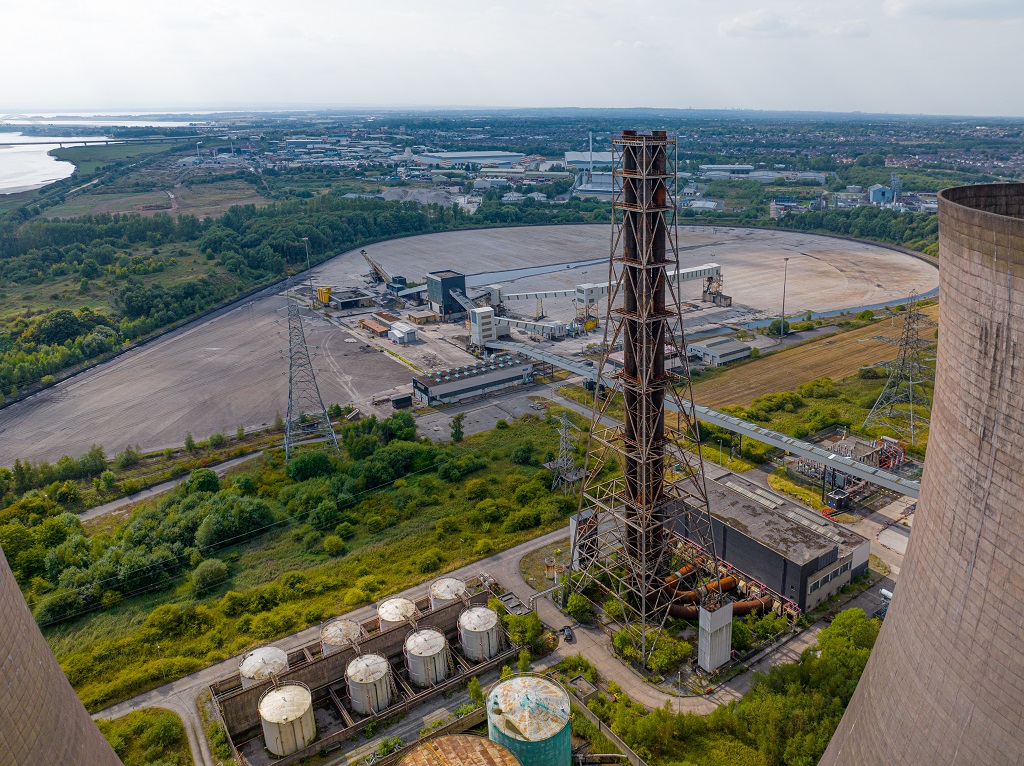P.P. O’Connor to flatten Fiddler’s Ferry
Peel NRE has appointed the demolition specialist to raze the former coal-fired power station near Warrington.
Scroll down to see drone photos of the cooling towers.
Fiddler’s Ferry Power Station is owned by Peel L&P subsidiary Peel NRE, which is working on a 10- to 15-year masterplan for the 820-acre brownfield site. One element of this proposal would be a 1.4m sq ft industrial scheme.
Peel NRE said it was P.P. O’Connor’s experience in complex demolitions that won them the contract, which was for an undisclosed amount.
The Trafford Park-based P.P. O’Connor led the demolition of INEOS in Runcorn, Stanlow Refinery in Ellesmere Port, and LyondellBasell in Carrington.
At Fiddler’s Ferry, the power station will be dismantled and destroyed in phases. The first of these phases will zero in on the coal stockyard, the site’s northern cooling towers, and a few ex-administrative buildings.
The cooling towers will be destroyed by the end of January 2024.
Kieran Tames, development director at Peel NRE, described the announcement of P.P. O’Connor as demolition contractor as a “major milestone” for the project.
“It’s reassuring to be working with industry experts, P.P. O’Connor as we demolish one of the country’s last remaining coal-fired power stations,” Tames said.
“We know that the demolition has been anticipated by communities, not just in Warrington but across the region so will ensure that residents will be kept updated on our demolition plans as we develop a precise timetable.”
P.P. O’Connor will be using a local workforce on the project, which will involve around 120 staff members.
“Fiddler’s Ferry is a highly prestigious location, and we are very proud to be involved in this project,” said P.P. O’Connor managing director Peter O’Connor. “We look forward to working with Peel NRE to achieve its vision in the regeneration of this strategic site.”
Click any image to launch gallery. All photos provided by Peel NRE.
- Various buildings and infrastructure will come down in the next wave of demolition. Credit: via Peel NRE










Well yes it would be. Manc company doing the flattening. My father helped build this lot in the sixties and Peel bought it for a song .
By Ted
The sad thing about demolishing the cooling towers is that most people have no idea how they were built and the skill and hard work required to do so. They are a work of art and when in operation they cooled the power station steam condensate in a very efficient way and did not require cooling fans – they cooled by natural air flow through the giant cooling towers. Cost a fortune to construct but this was in the days of the C.E.G.B which government owned.
R.I.P to a great work of art.
By Dave Reynolds
Biggest mistake ever. We need the reserve capacity from coal, keep the home fires burning. The situation with the war with Russia, means it is insane to close highly efficient power stations
By Nightwatchmen
We (as a country) will regret this, there is enough coal here in the uk for the next 400 years, and it has the lowest sulphur of any coal in the world
By Trevor
These cooling towers are a iconic. It is sad that one cannot be retained as a symbol of the site’s past, and act as a landmark for the site’s future
By Prescotian
I’m going to miss using Fiddlers Ferry Cooling Towers as a reference point on many walks across the North West.
By Drew
We really do need to think about things. We won’t allow fracking but we want gas – so we import Fracked gas from other countries because that’s ok? We import coal from other countries – as someone noted with more sulphur. Are we heading or already in a situation like industry and manufacturing and farming – where very little is made here and we cannot survive without other countries. I personally will miss seeing the towers.
By Annie Baines
I would point out that the cooling towers could hold water tanks, where the falling water can be used to power water wheels. The water would be pumped up using windmill power and the eight towers then act as energy reservoir batteries for national electricity supply.
By Philip John Allen